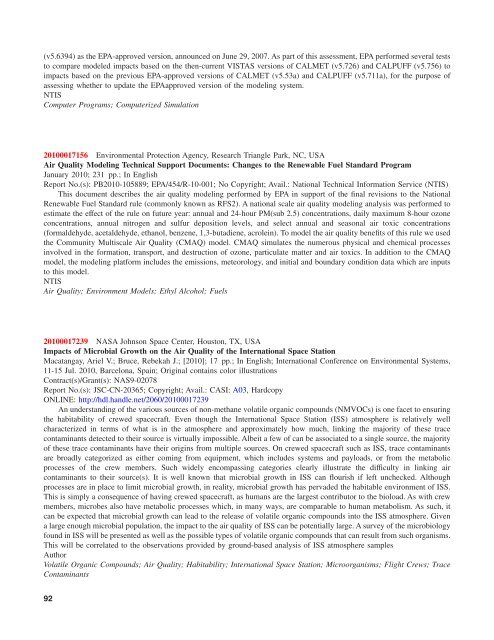NASA Scientific and Technical Aerospace Reports - The University ...
NASA Scientific and Technical Aerospace Reports - The University ...
NASA Scientific and Technical Aerospace Reports - The University ...
You also want an ePaper? Increase the reach of your titles
YUMPU automatically turns print PDFs into web optimized ePapers that Google loves.
(v5.6394) as the EPA-approved version, announced on June 29, 2007. As part of this assessment, EPA performed several tests<br />
to compare modeled impacts based on the then-current VISTAS versions of CALMET (v5.726) <strong>and</strong> CALPUFF (v5.756) to<br />
impacts based on the previous EPA-approved versions of CALMET (v5.53a) <strong>and</strong> CALPUFF (v5.711a), for the purpose of<br />
assessing whether to update the EPAapproved version of the modeling system.<br />
NTIS<br />
Computer Programs; Computerized Simulation<br />
20100017156 Environmental Protection Agency, Research Triangle Park, NC, USA<br />
Air Quality Modeling <strong>Technical</strong> Support Documents: Changes to the Renewable Fuel St<strong>and</strong>ard Program<br />
January 2010; 231 pp.; In English<br />
Report No.(s): PB2010-105889; EPA/454/R-10-001; No Copyright; Avail.: National <strong>Technical</strong> Information Service (NTIS)<br />
This document describes the air quality modeling performed by EPA in support of the final revisions to the National<br />
Renewable Fuel St<strong>and</strong>ard rule (commonly known as RFS2). A national scale air quality modeling analysis was performed to<br />
estimate the effect of the rule on future year: annual <strong>and</strong> 24-hour PM(sub 2.5) concentrations, daily maximum 8-hour ozone<br />
concentrations, annual nitrogen <strong>and</strong> sulfur deposition levels, <strong>and</strong> select annual <strong>and</strong> seasonal air toxic concentrations<br />
(formaldehyde, acetaldehyde, ethanol, benzene, 1,3-butadiene, acrolein). To model the air quality benefits of this rule we used<br />
the Community Multiscale Air Quality (CMAQ) model. CMAQ simulates the numerous physical <strong>and</strong> chemical processes<br />
involved in the formation, transport, <strong>and</strong> destruction of ozone, particulate matter <strong>and</strong> air toxics. In addition to the CMAQ<br />
model, the modeling platform includes the emissions, meteorology, <strong>and</strong> initial <strong>and</strong> boundary condition data which are inputs<br />
to this model.<br />
NTIS<br />
Air Quality; Environment Models; Ethyl Alcohol; Fuels<br />
20100017239 <strong>NASA</strong> Johnson Space Center, Houston, TX, USA<br />
Impacts of Microbial Growth on the Air Quality of the International Space Station<br />
Macatangay, Ariel V.; Bruce, Rebekah J.; [2010]; 17 pp.; In English; International Conference on Environmental Systems,<br />
11-15 Jul. 2010, Barcelona, Spain; Original contains color illustrations<br />
Contract(s)/Grant(s): NAS9-02078<br />
Report No.(s): JSC-CN-20365; Copyright; Avail.: CASI: A03, Hardcopy<br />
ONLINE: http://hdl.h<strong>and</strong>le.net/2060/20100017239<br />
An underst<strong>and</strong>ing of the various sources of non-methane volatile organic compounds (NMVOCs) is one facet to ensuring<br />
the habitability of crewed spacecraft. Even though the International Space Station (ISS) atmosphere is relatively well<br />
characterized in terms of what is in the atmosphere <strong>and</strong> approximately how much, linking the majority of these trace<br />
contaminants detected to their source is virtually impossible. Albeit a few of can be associated to a single source, the majority<br />
of these trace contaminants have their origins from multiple sources. On crewed spacecraft such as ISS, trace contaminants<br />
are broadly categorized as either coming from equipment, which includes systems <strong>and</strong> payloads, or from the metabolic<br />
processes of the crew members. Such widely encompassing categories clearly illustrate the difficulty in linking air<br />
contaminants to their source(s). It is well known that microbial growth in ISS can flourish if left unchecked. Although<br />
processes are in place to limit microbial growth, in reality, microbial growth has pervaded the habitable environment of ISS.<br />
This is simply a consequence of having crewed spacecraft, as humans are the largest contributor to the bioload. As with crew<br />
members, microbes also have metabolic processes which, in many ways, are comparable to human metabolism. As such, it<br />
can be expected that microbial growth can lead to the release of volatile organic compounds into the ISS atmosphere. Given<br />
a large enough microbial population, the impact to the air quality of ISS can be potentially large. A survey of the microbiology<br />
found in ISS will be presented as well as the possible types of volatile organic compounds that can result from such organisms.<br />
This will be correlated to the observations provided by ground-based analysis of ISS atmosphere samples<br />
Author<br />
Volatile Organic Compounds; Air Quality; Habitability; International Space Station; Microorganisms; Flight Crews; Trace<br />
Contaminants<br />
92

















